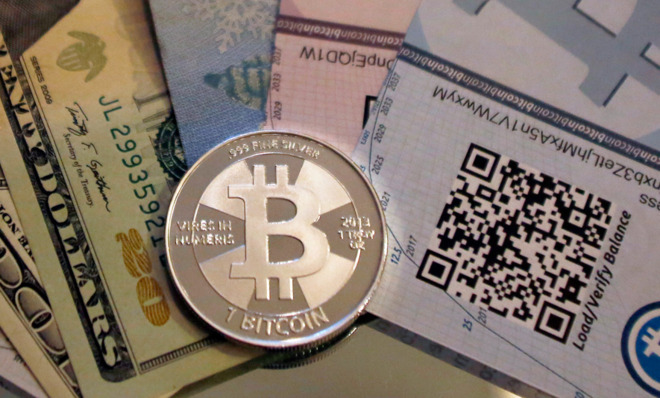Bitcoin falls below $500 — and it could go much lower
The digital currency is showing its inherent instability

Almost four months to the day since the digital cryptographic currency first rose in price above $1,000 per coin, Bitcoin is back below $500 over fears that China — where Bitcoin became popular as a means to evade the government's currency controls — is about to crack down on Bitcoin usage. This is just the latest setback in a difficult period for Bitcoin, which included the shutdown and bankruptcy of Mt. Gox, formerly the largest Bitcoin exchange, and the loss of millions of its customers' coins.
Bitcoin's growth up to this point has consisted of a series of bubbles — rising rapidly in price for a time, only to crash back down. However, Bitcoin has taken many more steps forward than backward. At $500, it's still much, much more highly-priced than it was at this time in 2013, 2012, or 2011. This has allowed it to retain forward momentum, bringing new users into the ecosystem. As a result, early investors made huge returns on their investments, like the Norwegian man who bought $27 worth of Bitcoin in 2009, forgot about them, and discovered they were worth $886,000 by 2013. These kinds of stories generated media buzz that only fed the Bitcoin craze, and helped the currency ride out slumps.
But it was always bound to face a more prolonged slump. For most assets, there are fundamentals that anchor the price. For example, for oil and gas, there is the cost of extraction from the ground. For stocks, there is the value of the company's assets, and its revenues and profits. For the U.S. dollar, there is the fact that it is legal tender for purchasing goods and services in the United States, and acceptable for payment of taxes. For Bitcoin, there are fewer fundamentals that firmly anchor its price. The cost of Bitcoin mining is one guiding factor, but this is highly variable due to the network difficulty rate (i.e. the difficulty of the mathematical puzzles that computers have to solve to mine Bitcoins), the inconsistent cost and efficiency of mining hardware, and the cost of electricity. And aside from recently mined coins, there are already a huge stock of pre-existing coins that were mined at wildly different costs.
The Week
Escape your echo chamber. Get the facts behind the news, plus analysis from multiple perspectives.

Sign up for The Week's Free Newsletters
From our morning news briefing to a weekly Good News Newsletter, get the best of The Week delivered directly to your inbox.
From our morning news briefing to a weekly Good News Newsletter, get the best of The Week delivered directly to your inbox.
Without an anchor, Bitcoin's price could continue rising as long as people kept buying into the Bitcoin system — especially people who were looking for a profit. Similarly, with the price of Bitcoin in a slump, the price can go much, much lower now that Bitcoin has lost its forward momentum. And the falling price will drive out the speculators who once bought into Bitcoin in hope of a quick buck, further pushing the price downward.
Indeed, it would be better if the price of Bitcoin stabilized relative to the dollar and other state-backed currencies. Yes, rapid price growth might drive lots of users into Bitcoin. But the downside to soaring booms is severe busts. It is this volatility that is likely to restrain the widespread adoption of crypto-currencies as media of exchange. A get-rich-quick scheme cannot become money.
But can this kind of system stabilize in price? Bitcoin is designed to be scarce, capping out at a theoretical total of 21 million coins. Unlike a currency that has the backing of a central bank — which can adjust interest rates and vary the amount of base currency in the economy to match the level of demand — Bitcoin continues growing at a set, pre-determined pace. This inherent scarcity — combined with the fact that when Bitcoins are lost, they are lost from the Bitcoin supply forever — is inherently prone to supply squeezes, and is thus inherently destabilizing.
Of course, the point of Bitcoin was not to be a get rich quick scheme, but to introduce a decentralized payments system, and in that sense it has absolutely been a success. It can be used for payments across the internet, and has spawned a number of copycat protocols, such as Litecoin, Dogecoin, Peercoin, Namecoin, and Maxcoin.
A free daily email with the biggest news stories of the day – and the best features from TheWeek.com
But Bitcoin's current slump is likely to give other crypto-currencies like Dogecoin — which do not suffer from Bitcoin's inherent supply limitations — a chance to prove themselves as media of exchange. By removing such limitations, these currencies will not see the same kind of price appreciation that Bitcoin has enjoyed. But they will avoid the volatility produced by profit-hungry speculators, which may well be key to gaining more mainstream acceptance.
John Aziz is the economics and business correspondent at TheWeek.com. He is also an associate editor at Pieria.co.uk. Previously his work has appeared on Business Insider, Zero Hedge, and Noahpinion.
-
 Political cartoons for January 4
Political cartoons for January 4Cartoons Sunday's political cartoons include a resolution to learn a new language, and new names in Hades and on battleships
-
 The ultimate films of 2025 by genre
The ultimate films of 2025 by genreThe Week Recommends From comedies to thrillers, documentaries to animations, 2025 featured some unforgettable film moments
-
 Political cartoons for January 3
Political cartoons for January 3Cartoons Saturday's political cartoons include citizen journalists, self-reflective AI, and Donald Trump's transparency